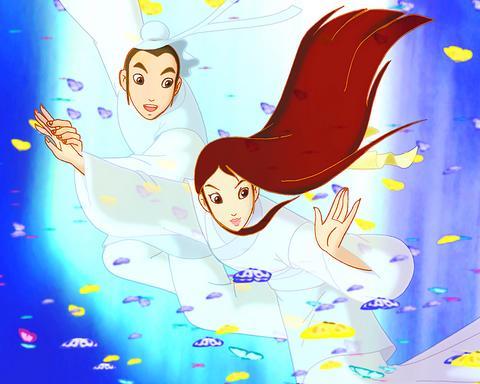As the first animated work to adapt the classic Chinese love story of the same name, Butterfly Lovers: Leon and Jo (
It is an acceptable film. As a tragedy, it makes you cry. And as a story about Chinese culture and sentiment, it has also got the right feel. There are even two Mando-pop divas singing love songs in the movie, adding more touching sentiment.
However, it is not hard to find some obvious problems.

PHOTO COURTESY OF CMP
The story of Liang Shan-po (
In order to pursue her studies, Jo dresses as a boy when she meets Leon on the way to school. They quickly become best friends, carrying on a flirtation that hints at Jo's sex. When Jo is revealed as a woman, Leon immediately falls in love with her, only to find out she is about to married, forced by her father to couple with the son from a rich family.
Those familiar with Disney animations will find the animation work in this movie a little raw and the movement of the characters a bit stiff.
Those seeking a Pixar-standard of 3D animation may be a little disappointed. Fortunately, the music and the dubbing has added some class to the movie.
Both Rene Liu (
The music for the movie adapts the world-famous Butterfly Lovers Violin Concerto, by Chinese composers Chen Gang (
The flowing Chinese-style violins represent the "falling in love" segment; and the high and rapid tones represent the
"refusing to marry part."
At the end, the powerful sounds of gongs represents the climax of the tragedy -- as the protagonists metamorphose into butterflies.
The picture also improves when the pair are ready to sacrifice their love. The colors are glowing and their use is wilder, making for a more imaginative section of the movie.

Every now and then, it’s nice to just point somewhere on a map and head out with no plan. In Taiwan, where convenience reigns, food options are plentiful and people are generally friendly and helpful, this type of trip is that much easier to pull off. One day last November, a spur-of-the-moment day hike in the hills of Chiayi County turned into a surprisingly memorable experience that impressed on me once again how fortunate we all are to call this island home. The scenery I walked through that day — a mix of forest and farms reaching up into the clouds

With one week left until election day, the drama is high in the race for the Chinese Nationalist Party (KMT) chair. The race is still potentially wide open between the three frontrunners. The most accurate poll is done by Apollo Survey & Research Co (艾普羅民調公司), which was conducted a week and a half ago with two-thirds of the respondents party members, who are the only ones eligible to vote. For details on the candidates, check the Oct. 4 edition of this column, “A look at the KMT chair candidates” on page 12. The popular frontrunner was 56-year-old Cheng Li-wun (鄭麗文)

“How China Threatens to Force Taiwan Into a Total Blackout” screamed a Wall Street Journal (WSJ) headline last week, yet another of the endless clickbait examples of the energy threat via blockade that doesn’t exist. Since the headline is recycled, I will recycle the rebuttal: once industrial power demand collapses (there’s a blockade so trade is gone, remember?) “a handful of shops and factories could run for months on coal and renewables, as Ko Yun-ling (柯昀伶) and Chao Chia-wei (趙家緯) pointed out in a piece at Taiwan Insight earlier this year.” Sadly, the existence of these facts will not stop the

Oct. 13 to Oct. 19 When ordered to resign from her teaching position in June 1928 due to her husband’s anti-colonial activities, Lin Shih-hao (林氏好) refused to back down. The next day, she still showed up at Tainan Second Preschool, where she was warned that she would be fired if she didn’t comply. Lin continued to ignore the orders and was eventually let go without severance — even losing her pay for that month. Rather than despairing, she found a non-government job and even joined her husband Lu Ping-ting’s (盧丙丁) non-violent resistance and labor rights movements. When the government’s 1931 crackdown